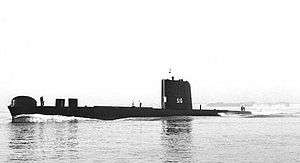HMS Oracle (S16)
HMS Oracle was an Oberon-class submarine of the Royal Navy.
 HMS Oracle | |
| History | |
|---|---|
| Name: | HMS Oracle |
| Builder: | Cammell Laird, Birkenhead |
| Laid down: | 26 April 1960 |
| Launched: | 26 September 1961 |
| Commissioned: | 14 February 1963 |
| Decommissioned: | 18 September 1993 |
| Fate: | Transferred to Pounds scrapyard, Portsmouth in 1997 for breaking up, completed in mid-2003.[1] |
| General characteristics as designed | |
| Class and type: | Oberon-class submarine |
| Displacement: |
|
| Length: |
|
| Beam: | 26.5 feet (8.1 m) |
| Draught: | 18 feet (5.5 m) |
| Propulsion: |
|
| Speed: |
|
| Complement: | 68 (6 officers, 62 enlisted) |
| Sensors and processing systems: |
|
| Armament: |
|
Design and construction
The Oberon class was a direct follow on of the Porpoise-class, with the same dimensions and external design, but updates to equipment and internal fittings, and a higher grade of steel used for fabrication of the pressure hull.[2]
As designed for British service, the Oberon-class submarines were 241 feet (73 m) in length between perpendiculars and 295.2 feet (90.0 m) in length overall, with a beam of 26.5 feet (8.1 m), and a draught of 18 feet (5.5 m).[3] Displacement was 1,610 tons standard, 2,030 tons full load when surfaced, and 2,410 tons full load when submerged.[3] Propulsion machinery consisted of 2 Admiralty Standard Range 16 VMS diesel generators, and two 3,000 shaft horsepower (2,200 kW) electric motors, each driving a 7-foot diameter (2.1 m) 3-bladed propeller at up to 400 rpm.[3] Top speed was 17 knots (31 km/h; 20 mph) when submerged, and 12 knots (22 km/h; 14 mph) on the surface.[3] Eight 21-inch (530 mm) diameter torpedo tubes were fitted (six facing forward, two aft), with a total payload of 24 torpedoes.[3] The boats were fitted with Type 186 and Type 187 sonars, and an I-band surface search radar.[3] The standard complement was 68: 6 officers, 62 sailors.[3]
Oracle was laid down by Cammell Laird on 26 April 1960, and launched on 26 September 1961.[3] The boat was commissioned into the Royal Navy on 14 February 1963.[3]
Operational history
Oracle performed three-month secret 'observation' missions in the Arctic region in 1965 during the Cold War period and was on stand-by duty during the tumultuous period when Rhodesia announced independence.
Oracle attended the 1977 Silver Jubilee Fleet Review off Spithead when she was part of the Submarine Flotilla.[4]
Oracle featured in the 1980s BBC documentary series Submarine as she was host to Perisher trainee submarine commanders.
Decommissioning and fate
Oracle was paid off on 18 September 1993.
References
- Colledge, J. J.; Warlow, Ben (2006) [1969]. Ships of the Royal Navy: The Complete Record of all Fighting Ships of the Royal Navy (Rev. ed.). London: Chatham Publishing. ISBN 978-1-86176-281-8.
- Chant, Christopher (2005). Submarine Warfare Today: The World's Deadliest Underwater Weapons Systems. Wigston: Silverdale Books. p. . ISBN 1-84509-158-2. OCLC 156749009.
- Moore, John, ed. (1977). Jane's Fighting Ships 1977-78. Jane's Fighting Ships (80th ed.). London: Jane's Yearbooks. p. 490. ISBN 0531032779. OCLC 18207174.
- Official Souvenir Programme, 1977. Silver Jubilee Fleet Review, HMSO
Publications
- Colledge, J. J.; Warlow, Ben (2006) [1969]. Ships of the Royal Navy: The Complete Record of all Fighting Ships of the Royal Navy (Rev. ed.). London: Chatham Publishing. ISBN 978-1-86176-281-8.